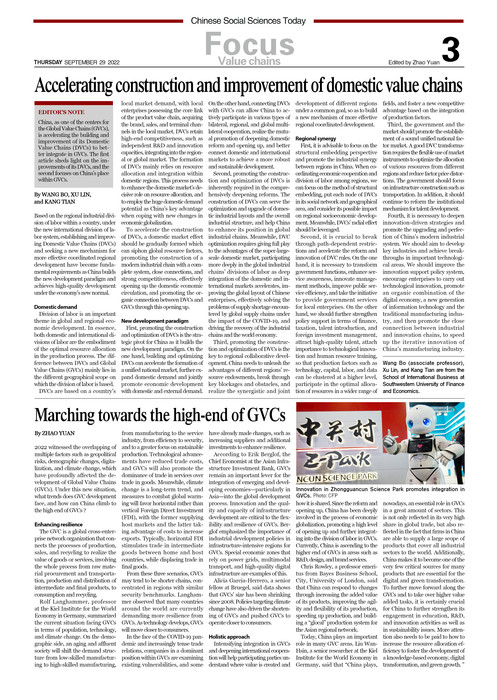Accelerating construction and improvement of domestic value chains
2022-09-29 14:38:32
By WANG BO, XU LIN,
and KANG TIAN
Based on the regional industrial division of labor within a country, under the new international division of labor system, establishing and improving Domestic Value Chains (DVCs) and seeking a new mechanism for more effective coordinated regional development have become fundamental requirements as China builds the new development paradigm and achieves high-quality development under the economy’s new normal.
Domestic demand
Division of labor is an important theme in global and regional economic development. In essence, both domestic and international divisions of labor are the embodiment of the optimal resource allocation in the production process. The difference between DVCs and Global Value Chains (GVCs) mainly lies in the different geographical scope on which the division of labor is based.
DVCs are based on a country’s local market demand, with local enterprises possessing the core link of the product value chain, acquiring the brand, sales, and terminal channels in the local market. DVCs retain high-end competitiveness, such as independent R&D and innovation capacities, integrating into the regional or global market. The formation of DVCs mainly relies on resource allocation and integration within domestic regions. This process needs to enhance the domestic market’s decisive role on resource allocation, and to employ the huge domestic demand potential as China’s key advantage when coping with new changes in economic globalization.
To accelerate the construction of DVCs, a domestic market effect should be gradually formed which can siphon global resource factors, promoting the construction of a modern industrial chain with a complete system, close connections, and strong competitiveness, effectively opening up the domestic economic circulation, and promoting the organic connection between DVCs and GVCs through this opening up.
New development paradigm
First, promoting the construction and optimization of DVCs is the strategic pivot for China as it builds the new development paradigm. On the one hand, building and optimizing DVCs can accelerate the formation of a unified national market, further expand domestic demand and jointly promote economic development with domestic and external demand. On the other hand, connecting DVCs with GVCs can allow China to actively participate in various types of bilateral, regional, and global multilateral cooperation, realize the mutual promotion of deepening domestic reform and opening up, and better connect domestic and international markets to achieve a more robust and sustainable development.
Second, promoting the construction and optimization of DVCs is inherently required in the comprehensively deepening reforms. The construction of DVCs can serve the optimization and upgrade of domestic industrial layouts and the overall industrial structure, and help China to enhance its position in global industrial chains. Meanwhile, DVC optimization requires giving full play to the advantages of the super-large-scale domestic market, participating more deeply in the global industrial chains’ divisions of labor as deep integration of the domestic and international markets accelerates, improving the global layout of Chinese enterprises, effectively solving the problems of supply shortage encountered by global supply chains under the impact of the COVID-19, and driving the recovery of the industrial chains and the world economy.
Third, promoting the construction and optimization of DVCs is the key to regional collaborative development. China needs to unleash the advantages of different regions’ resource endowments, break through key blockages and obstacles, and realize the synergistic and joint development of different regions under a common goal, so as to build a new mechanism of more effective regional coordinated development.
Regional synergy
First, it is advisable to focus on the structural embedding perspective and promote the industrial synergy between regions in China. When coordinating economic cooperation and division of labor among regions, we can focus on the method of structural embedding, put each node of DVCs in its social network and geographical area, and consider its possible impact on regional socioeconomic development. Meanwhile, DVCs’ radial effect should be leveraged.
Second, it is crucial to break through path-dependent restrictions and accelerate the reform and innovation of DVC rules. On the one hand, it is necessary to transform government functions, enhance service awareness, innovate management methods, improve public service efficiency, and take the initiative to provide government services for local enterprises. On the other hand, we should further strengthen policy support in terms of finance, taxation, talent introduction, and foreign investment management, attract high-quality talent, attach importance to technological innovation and human resource training, so that production factors such as technology, capital, labor, and data can be clustered at a higher level, participate in the optimal allocation of resources in a wider range of fields, and foster a new competitive advantage based on the integration of production factors.
Third, the government and the market should promote the establishment of a sound unified national factor market. A good DVC transformation requires the flexible use of market instruments to optimize the allocation of various resources from different regions and reduce factor price distortions. The government should focus on infrastructure construction such as transportation. In addition, it should continue to reform the institutional mechanism for talent development.
Fourth, it is necessary to deepen innovation-driven strategies and promote the upgrading and perfection of China’s modern industrial system. We should aim to develop key industries and achieve breakthroughs in important technological areas. We should improve the innovation support policy system, encourage enterprises to carry out technological innovation, promote an organic combination of the digital economy, a new generation of information technology and the traditional manufacturing industry, and then promote the close connection between industrial and innovation chains, to speed up the iterative innovation of China’s manufacturing industry.
Wang Bo (associate professor), Xu Lin, and Kang Tian are from the School of International Business at Southwestern University of Finance and Economics.


